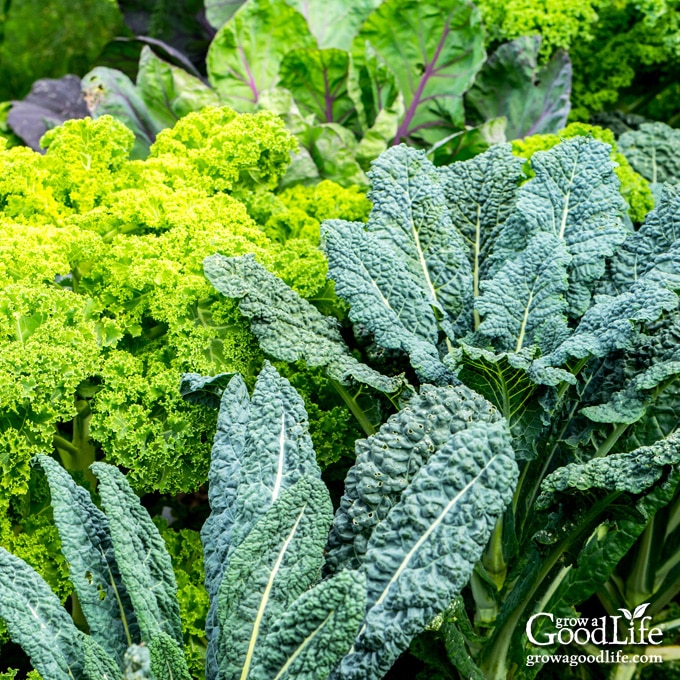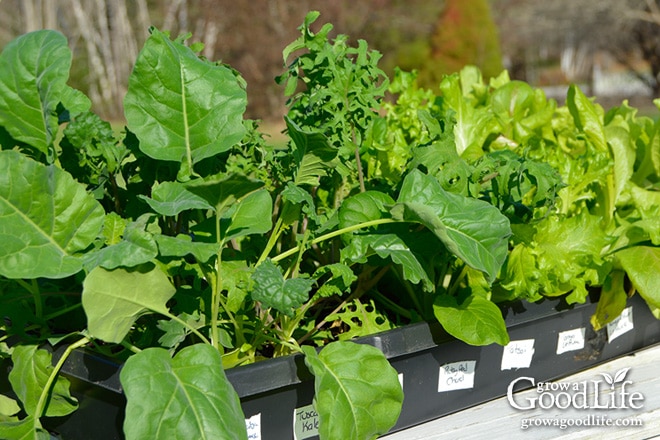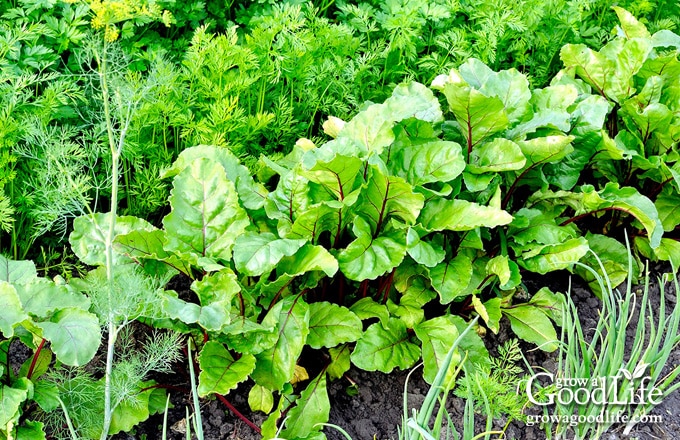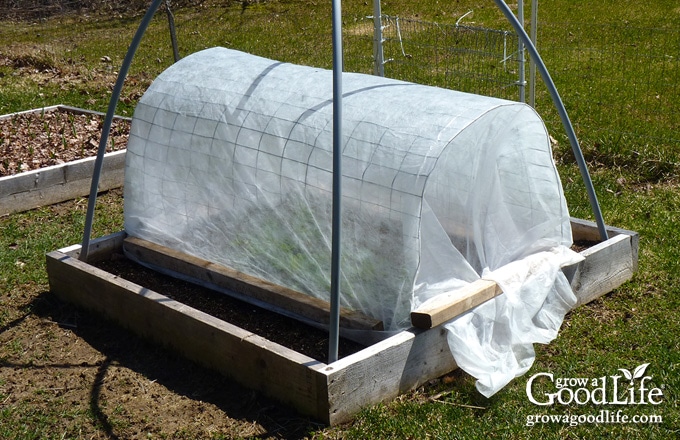Tips for Growing a Fall Vegetable Garden
This post may contain affiliate links, which means that I may receive a commission if you make a purchase using these links. As an Amazon Associate I earn from qualifying purchases.
Discover the secrets to a thriving fall vegetable garden with our expert tips! Learn how to plan, plant, and extend your growing season for a bountiful harvest. Embrace the joys of fall gardening with our comprehensive guide.

As the warm days of summer wane and the cool breeze of autumn sets in, avid gardeners know that it’s time to embrace the beauty and bounty of a fall vegetable garden.
While many may think of vegetable gardening as primarily a spring and summer activity, fall gardening offers many benefits and exciting opportunities to cultivate various delicious and nutritious crops.
Fall gardening is a great way to maximize your garden’s productivity and ensure a continuous harvest. Extending the growing season into the cooler months allows you to enjoy a wide range of fresh, homegrown produce well beyond the typical summer harvest.
Advantages of Growing Vegetables in Fall
Fall vegetable gardens provide a golden opportunity to grow crops that thrive in lower temperatures and are better suited to autumn’s cooler, more stable weather. These cool-season vegetables often have better flavor and texture when they mature in fall’s crisp, refreshing air. Here are some advantages to growing fall crops:
- Fewer Pests and Diseases: As the heat of summer diminishes, so does the prevalence of many garden pests and diseases. Fall gardening allows you to escape the peak pest season, resulting in healthier plants.
- Milder Weather for Gardening: Working in the garden becomes more enjoyable as temperatures become more moderate in the fall. The cooler weather is not only comfortable for gardeners but also helps prevent stress on the plants.
- Reduced Watering Needs: Cooler temperatures typically mean reduced evaporation rates, resulting in lower watering demands for your fall crops compared to the thirsty summer months.
- Greater Success with Leafy Greens: Leafy greens, such as lettuce, spinach, and arugula, tend to bolt and turn bitter in hot weather. Growing them in the cooler fall temperatures allows you to enjoy a more extended period of tender, fresh greens.
- Enhanced Flavor and Sweetness: Some vegetables, like kale, carrots, and Brussels sprouts, develop sweetness and flavor after experiencing light frost. By planting in the fall, these crops have the opportunity to mature in the best possible conditions, resulting in a more flavorful harvest.
Planning Your Fall Vegetable Garden
You may be in the middle of your summer harvest, but with a little planning and preparation, you can ensure a thriving fall vegetable garden. Before you begin, take the time to evaluate your garden space and consider the following factors:
- Frost Dates: Know the average date of the first frost in your area. This information will guide you in determining the best crops to grow and when to plant them to ensure a harvest before winter.
- Sunlight Exposure: Ensure your fall garden receives adequate sunlight for the type of crops you are growing. If trees shade your garden for part of the day, this spot is ideal for planting fall crops in late July, August, and September. The partial shade will keep the area cool during the heat of late summer, allowing your plants to become established. Then they will flourish once the leaves fall and they have access to full sun.
- Develop a Fall Planting Schedule: Developing a seed-starting schedule for fall can help you plan and organize your vegetable garden effectively. A well-thought-out schedule will help you direct sow or transplant your fall crops at the right time to allow them to mature into a bountiful harvest before heavy frost.
- Replenish the Soil: Your soil will need a good boost of nutrients to replace the ones used by your summer crops. Nourish your soil with a generous amount of finished compost or well-rotted organic matter to enrich the nutrients available to your plants.
You may also find the following articles on planning your vegetable garden helpful:
- Mapping the Garden Beds: Before you dive into planting your fall vegetable garden, it may be helpful to have a well-thought-out plan. Mapping your garden beds allows you to visualize the layout, determine the available space, and strategically organize your crops for optimal growth and productivity.
- Using Grow Lights for Starting Seeds: Starting your fall crops from seeds indoors can give them a head start and provide better control over germination and early growth.
- 10 Steps to Starting Seedlings Indoors: This article offers step-by-step guidance on providing the ideal conditions for your seedlings, including temperature, humidity, and proper watering. Discover valuable tips for preventing common seedling issues and setting them up for a successful transition to the outdoor garden.
- How to Direct Sow Seeds: Directly sowing seeds outdoors is best for some cool-season crops. This article provides tips and techniques for sowing seeds directly in the garden to help you establish a successful direct-sown crop in your fall vegetable garden.
- Succession Planting Tips: To make the most of your fall vegetable garden and extend your harvest throughout the season, consider implementing succession planting for some crops. Succession planting involves staggering the sowing of seeds or transplanting seedlings at regular intervals, ensuring a continuous supply of fresh produce.
By setting the stage and understanding the advantages of cool-season gardening, you are ready to grow a bountiful fall vegetable garden. In the following sections, we will delve deeper into the specific steps and considerations for achieving success in your fall gardening endeavors. Let’s get started!

Fall Vegetables to Plant
So what are the best fall vegetables to plant? Choose cool-season crops that are well-suited to your climate and will mature before heavy frost. To diversify your harvest, consider growing a mix of leafy greens, root vegetables, and brassicas. Here are some cool-season crops to consider growing in fall:
- Arugula: A peppery and flavorful green, ready for harvest in about 40 to 50 days. Succession sow every 2 to 3 weeks for a continuous harvest.
- Beets: Both the roots and greens of beets are edible, and they are ready to harvest in around 50 to 60 days.
- Bok Choy: This popular Asian vegetable can be harvested in 45 to 60 days, depending on the size desired.
- Broccoli: A cool-season crop that thrives in fall weather and produces delicious, nutrient-rich heads. Choose quick maturing varieties and plant transplants to ensure you get a harvest before winter.
- Brussels Sprouts: These mini cabbages develop the best flavor after exposure to light frost, making them ideal for fall harvest. Grow or purchase seedlings so they mature before winter.
- Cabbage: Different varieties of cabbage, such as green, red, and savoy, can be harvested in the fall. Choose varieties that will mature in the number of days before hard frost, and either start seedlings early or buy plant starts at your local garden center.
- Carrots: Quick-maturing carrots can be harvested in 50 to 60 days, depending on the variety.
- Cauliflower: Like broccoli, cauliflower is well-suited for fall planting and harvest. Select a variety that matures quickly and plant transplants for a fall harvest.
- Celery: Choose quick maturing varieties, and begin harvesting in 60 to 90 days, depending on the variety and growing conditions.
- Collards: These are nutritious and flavorful leafy greens that thrive in cooler temperatures, offering a steady supply of vitamin-rich leaves for your fall garden.
- Green Onions (Scallions): These immature onions can be harvested in as little as 30 days. Most will overwinter well and begin producing again in early spring.
- Kale: A cold-hardy leafy green that becomes sweeter after experiencing frost. Ready for harvesting in about 40 to 60 days.
- Kohlrabi: Thrives in cooler temperatures and is more tolerant of chilly weather than hot summers. Fall’s cool temperatures are ideal for producing crisp, tender stems ready in about 50 days.
- Lettuce: Depending on the variety, lettuce can be harvested in 30 to 60 days. Succession sow for a continuous harvest.
- Mizuna: An Asian green with a mild, peppery flavor, ready for harvest in 20 to 40 days.
- Mustard Greens: Spicy and fast-growing greens, usually ready to harvest in 30 to 40 days.
- Potatoes: Some quick maturing potato varieties, such as Dark Red Norland, Golden Glove, and Yukon Gold, are usually ready for harvest in 55 to 70 days, depending on growing conditions.
- Radishes: This root vegetable grows quickly and can be harvested in just 20 to 30 days. To ensure a continuous harvest, sow new seeds every 2 weeks.
- Snow Peas and Snap Peas: Both grow well in cool temperatures and can tolerate light frosts, which can even enhance their sweetness.
- Spinach: A quick-growing, cold-hardy leafy green that can be harvested in 40 to 50 days.
- Swiss Chard: A nutritious leafy green that can be harvested as early as 50 days and throughout the fall season.
- Tatsoi: An Asian green, ready to harvest in 35 to 45 days.
- Turnips: Choose quick-growing roots so they mature before the ground freezes, ensuring a successful fall harvest in around 50 to 60 days.
These crops can vary in their specific growing times depending on weather conditions, variety, soil nutrition, and care, so it’s always a good idea to check the seed packet or plant label for the estimated maturity date. By selecting short-season varieties and planting at the right times, you can enjoy a bountiful fall harvest and even some quick, early yields!

Create a Fall Planting Schedule
Now that you have an idea of what you can grow, you can create a planting schedule based on the average first frost date in your area. This will help you determine the appropriate planting dates for each crop, considering the time needed for seeds to germinate and mature to harvestable size. Here are the steps to create a fall seed-starting schedule:
- Identify the Frost Date for Fall Planting: Determine the average first expected frost date in your area. You can obtain this information from local sources such as neighbors, your local nursery, extension office, or use online resources like PlantMaps.com, where you can enter your zip code to get the frost date for your location.
- Use a Chart to Plan Your Fall Seedlings: Create a spreadsheet or sketch out a chart with the following headers: Description, # of plants, Seed Starting Date, Actual Seed Starting Date, Germination Date, Transplant Date, and Actual Transplant Date. Rounding the dates to the nearest Sunday date can help with simplicity and organization.
- Figure Out the Best Timing for Each Crop: Refer to the back of the seed packages for instructions on when to sow seeds indoors and when to transplant seedlings into the vegetable garden. Use the general guidelines below to determine the timing based on your estimated first frost date:
• 10 to 12 weeks before first frost: For vegetables like broccoli, cabbage, cauliflower, Brussels sprouts, kale, Swiss chard, and others in the Brassicaceae family, start the seeds indoors under lights approximately 10 to 12 weeks before the expected first frost date. This allows the plants to establish strong root systems and develop well before transplanting them into the garden when space becomes available and night temperatures start to cool.
• 4 to 8 weeks before first frost: For vegetables like spinach, lettuce, radishes, carrots, beets, turnips, and other cold-hardy crops that can tolerate cooler temperatures, directly sow the seeds in the garden approximately 4 to 8 weeks before the first expected frost. These crops tend to germinate and grow well in cooler weather, making it easier to grow them directly outdoors. - Record Your Seed Starting Details: Fill in the information for each crop in your spreadsheet. Include the name and variety of the crop in the description column, the number of seedlings you will need, the date to sow the seeds indoors or directly in the garden, and the date to transplant the seedlings into the garden. Continue this for each crop you plan on growing.
By following these steps and maintaining a well-organized seed-starting schedule, you can optimize your fall vegetable gardening and increase your chances of a bountiful harvest.
Preparing the Garden Bed
Healthy soil provides the essential elements for strong root development, vigorous growth, and abundant yields, setting the stage for a successful fall vegetable garden. Before you plant, take the time to prepare your garden beds: Follow these steps to ready the soil for fall planting:
- Clear the Area: Remove any remaining summer crops and debris from the garden bed. Eliminate any persistent weeds to prevent them from competing with your fall crops for nutrients and water. Clearing the area will ensure that your fall vegetables have ample space to grow without competition.
- Add Compost: Your veggies will thrive in nutrient-rich soil, and incorporating organic matter can significantly improve the soil’s fertility. Add a generous layer of finished compost to the garden bed. Compost enriches the soil with essential nutrients and helps improve soil structure, water retention, and aeration. Aim to mix in a 2 to 4-inch layer of compost into the top few inches of soil.
- Consider Using Organic Fertilizers: If you are low on compost or if your soil lacks nutrients, consider using organic fertilizer, such as Garden Tone or Plant Tone, to help feed your plants. Follow the recommended application rates to avoid over-fertilization.
By thoroughly preparing your garden bed and incorporating fresh organic matter and nutrients, you create an ideal foundation for your fall crops to thrive.
Planting Your Fall Vegetable Garden
Once you have seeds, transplants and have prepared your garden beds, it is time to get your cool-season crops into the ground. Use your planting schedule as a guideline to plant your fall vegetable garden. The sooner your fall garden is planted, the easier it is for the plants to become established and produce harvests before heavy frost arrives:
- Transplant Seedlings: For transplants, harden off your seedlings to help them adapt to the outdoor environment. Then carefully remove the seedlings from their containers, and plant them into the prepared garden beds. Space the plants as recommended on the seed package to ensure they have enough room to grow and thrive. Water them regularly to help them establish their new home in the garden.
- Direct Sow Seeds: For direct-sown seeds, create furrows or planting holes, plant the seeds at the correct depth, and cover them gently with soil. Water the area evenly to kickstart germination and provide the moisture needed for successful seedling emergence.
- Provide Care as Needed: As your fall garden begins to take shape, maintain a consistent watering schedule, paying attention to the specific water requirements of each crop. Proper watering is essential for steady growth and robust harvests. You can add a nice layer of organic mulch to help suppress weeds, hold in moisture, and insulate the soil. Regularly inspect your plants for signs of pests or diseases, and take prompt action if any issues arise.
Soon your fall garden will grow and transform into a vibrant tapestry of leafy green growth. As the days grow shorter and the air crisper, your cool-season crops will thrive and reward you with an abundance of fresh and nutritious produce.

Tips for Extending the Growing Season
As the fall season progresses and the weather gets colder, it’s understandable to want to prolong the growth of your fall crops.
Some vegetables, like beets, carrots, cauliflower, celery, chard, lettuce, and potatoes, are semi-hardy and can handle light frosts with temperatures as low as 32˚F. On the other hand, hardy vegetables such as broccoli, Brussels sprouts, cabbage, collards, green onions, kale, kohlrabi, mustard greens, peas, radishes, spinach, and turnips can withstand even harder frosts, as low as 20˚F.
While most fall crops can withstand light and heavy frosts, you can use several effective techniques to protect your plants from chilly weather and create a more favorable environment for continued growth. Here are some valuable tips for extending the growing season:
Using Row Covers and Cloches
Row covers and cloches are simple yet effective tools for providing extra protection to your fall crops. These lightweight covers act as a physical barrier, shielding plants from frost, chilling winds, and pests while still allowing sunlight and air to penetrate. Here’s how to use them:
- Row Covers: Row covers are large sheets of lightweight fabric or plastic that are draped over rows of plants. They come in various thicknesses, each offering different levels of frost protection. Secure the covers with stakes or clips to keep them in place. Row covers can add a few degrees of warmth, creating a microclimate that helps prevent frost damage and keeps the plants cozy during cold nights.
- Cloches: Cloches are individual protective covers that shield plants. They can be made from various materials, such as glass jars, plastic bottles with the bottom cut off, or purpose-built cloche domes. Place them over young seedlings or vulnerable plants to offer localized protection. Cloches trap heat and humidity, creating a warmer environment for the covered plants.
Remember to monitor the temperature regularly and remove the covers during warmer days or when temperatures rise to prevent overheating. You may want to take a look at this article that provides additional helpful tips on protecting your plants from frost: 6 Ways to Protect Plants from Frost.

Building Cold Frames and Greenhouses
Cold frames and greenhouses are excellent structures for extending the growing season, particularly in colder climates. These structures offer a controlled environment allowing you to grow vegetables well into winter. Here’s how to utilize them:
- Cold Frames: A cold frame is a bottomless box with a transparent lid that acts as a mini-greenhouse. The top is usually sloped to capture maximum sunlight and retain heat. You can purchase pre-made cold frames or build your own using wood and old windows. Place the cold frame over your garden bed, and it will trap warmth from sunlight while protecting your plants from harsh elements. It’s an ideal space for hardening off seedlings before transplanting them into the garden.
- Greenhouses: Greenhouses are larger structures with transparent walls and roofs that provide a controlled and sheltered environment for plants. A greenhouse can extend the growing season significantly, allowing you to grow vegetables throughout the year, even in colder regions. Depending on your gardening needs and budget, you can opt for a simple hoop house or a more sophisticated permanent greenhouse.
With the use of row covers, cloches, cold frames, or greenhouses, you can shield your fall crops from inclement weather, prevent frost damage, and create a warm and nurturing environment for continued growth. These tips for extending the growing season will enable you to enjoy a longer and more productive fall vegetable garden, filling your table with fresh and delicious harvests well into the cooler months.
—
With the knowledge and insights gained from this guide, I hope you are encouraged to take the plunge into fall vegetable gardening. Through careful planning, dedication, and a little bit of Mother Nature’s magic, you’ll be rewarded with an abundant harvest that fills your plate and your freezer.
Dig Deeper into Fall Gardening
- Quick Growing Fall Vegetables Ready in 60 Days: If you are looking for fast results, check out this article for a selection of fast-maturing crops that will add fresh flavors to your autumn table in less than 60 days! From vibrant lettuces to speedy radishes, these varieties are perfect for the busy gardener seeking a bountiful fall harvest.
- Planting Cover Crops: Enhancing Soil Health: While you are planting fall veggies, also consider planting cover crops in any garden area where you are not growing fall crops to help enhance soil health. Cover crops, like clover or rye, help prevent erosion, suppress weeds, and fix nitrogen in the soil, benefiting next year’s garden.
- Keep Good Notes: Evaluate and Improve Your Fall Garden: Evaluate your fall gardening success and keep notes in your gardening journal. Some things to record include seed germination dates, harvest yields, pest pressure, frost dates, and anything you feel is important to remember for next year. This will help you evaluate the success of your schedule and make any necessary adjustments for next year’s fall vegetable garden.
Good planning is key to a successful vegetable garden
Whether you are new to growing your own food or have been growing a vegetable garden for years, you will benefit from some planning each year. You will find everything you need to organize and plan your vegetable garden in my PDF eBook, Grow a Good Life Guide to Planning Your Vegetable Garden.

